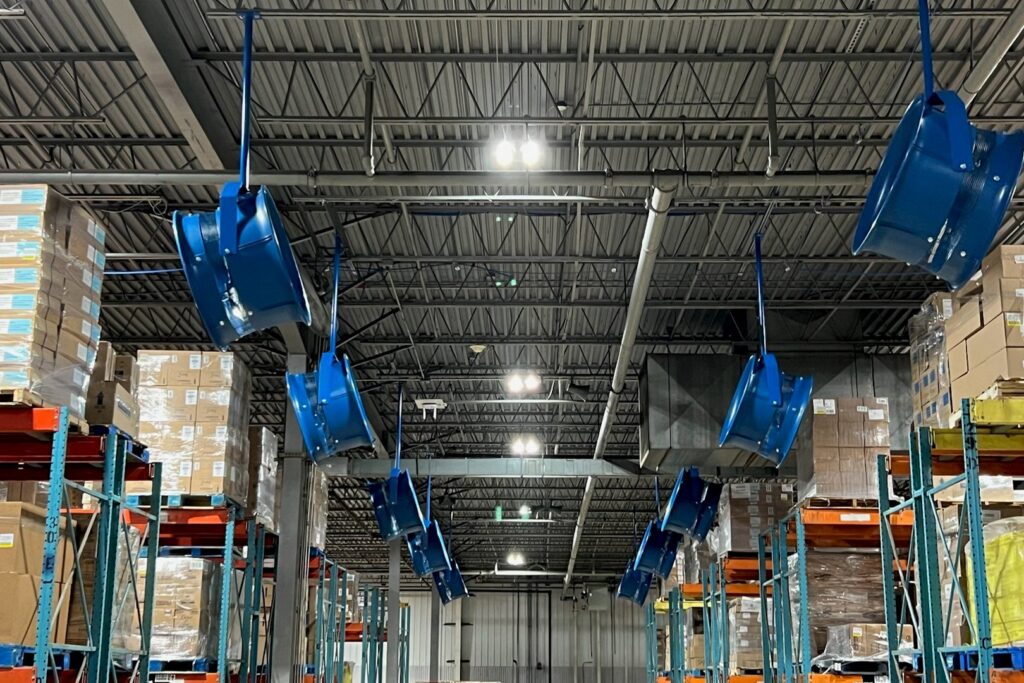The logistics industry relies on efficient air management systems to ensure safe, comfortable, and well-ventilated environments across warehouses, distribution centers, storage facilities, and transportation hubs. Industrial fans play a vital role in temperature control, ventilation, air circulation, and fume extraction, optimizing operational efficiency while maintaining product integrity and worker safety. Below are the key applications of industrial fans in logistics.
1. Warehouse Ventilation and Air Circulation
Large warehouses often experience poor air circulation, leading to stagnant air, heat buildup, and uneven temperature distribution.
-
High-volume low-speed (HVLS) fans move large amounts of air, creating a balanced airflow throughout the warehouse.
-
Exhaust fans remove hot, stale air, improving ventilation in enclosed storage areas.
-
Dock door ventilation fans help maintain fresh airflow in loading and unloading zones, reducing worker fatigue and discomfort.
2. Temperature Control for Inventory Storage
Temperature-sensitive goods, such as pharmaceuticals, electronics, and perishable foods, require stable environmental conditions.
-
Cooling fans in climate-controlled warehouses prevent temperature fluctuations that could affect stored products.
-
Industrial ventilation systems regulate air distribution in cold storage and refrigerated logistics facilities.
-
Air circulation fans maintain even cooling and prevent hotspots in large storage areas.
3. Dust and Air Quality Control in Distribution Centers
Logistics hubs and fulfillment centers generate dust, airborne particles, and vehicle emissions from constant material movement.
-
Industrial air purifiers with HEPA filters remove dust, reducing contamination of packaged goods.
-
Exhaust fans in packaging areas minimize exposure to adhesive fumes, ink particles, and box-cutting dust.
-
Air filtration systems in high-traffic areas ensure worker health by removing airborne contaminants.
4. Fume and Emission Extraction in Loading Bays
Logistics facilities handle large volumes of trucks, forklifts, and transport vehicles, producing exhaust fumes and carbon emissions.
-
Fume extraction fans in docking stations improve air quality by removing diesel exhaust and CO₂ buildup.
-
Ventilation systems in underground loading docks prevent the accumulation of toxic gases from idling trucks.
-
Airflow optimization in truck repair bays ensures safe working conditions for maintenance teams.
5. Moisture and Humidity Control for Packaging and Storage
Excess humidity can damage packaging materials, cause mold growth, and degrade stored products.
-
Dehumidification fans in paper and carton storage prevent material warping and moisture absorption.
-
Humidity control systems in food-grade warehouses ensure products remain dry and free from spoilage.
-
HVLS fans reduce condensation buildup on metal surfaces, preventing rust and structural damage.
6. Fire Safety and Smoke Ventilation
Warehouses and logistics centers must have proper smoke extraction systems to ensure safety in case of fire.
-
Smoke control fans quickly clear hazardous fumes from fire-affected areas, improving evacuation safety.
-
High-temperature exhaust fans help channel smoke outside, reducing visibility issues in emergencies.
-
Airflow management in fire-prone storage zones prevents heat accumulation in flammable material storage areas.
7. Employee Comfort and Workplace Safety
Workers in large logistics centers often experience heat stress, especially in summer months.
-
Large-diameter ceiling fans create a cooling effect, reducing heat-related fatigue.
-
Personal workstation fans provide targeted airflow, improving comfort for employees in packing and sorting stations.
-
Ventilation in mezzanine storage areas prevents overheating in upper-level workspaces.
Conclusion
Industrial fans are essential in logistics and supply chain operations, improving air circulation, temperature control, and worker safety. By integrating high-efficiency ventilation systems, logistics companies can enhance storage conditions, reduce operational risks, and maintain a safe, comfortable work environment for employees.

